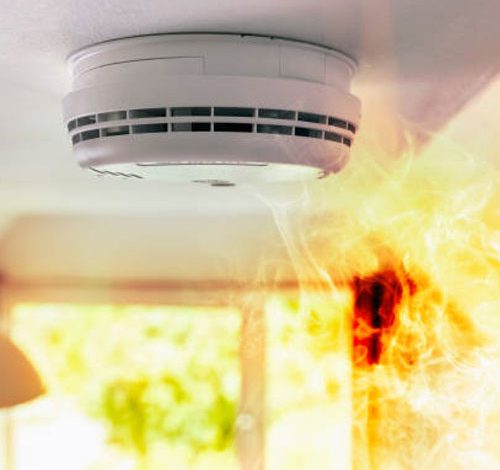The Best Places to Install a Fire Smoke Alarm for Maximum Safety
fire smoke alarm

Installing a fire smoke alarm is one of the most important steps you can take to protect your home and family. However, installing it in the right place is just as crucial as having one at all. Improper placement can lead to false alarms or worse—missed warnings during real emergencies.
At Sri Triveni Crafts, we’re dedicated to improving fire safety awareness and helping you set up your home with the best protection possible. This guide will help you understand where to place your fire smoke alarms for maximum efficiency and peace of mind.
Why Placement Matters ?
A well-installed fire smoke alarm can detect smoke within seconds and alert you before the situation escalates. Poor placement, however, can delay detection or cause frequent false alarms—both of which reduce the effectiveness of your home’s fire safety system.
The goal is to create a network of alarms that provide comprehensive coverage for every part of your home.
Key Areas to Install a Fire Smoke Alarm
1. Bedrooms and Sleeping Areas
Smoke can be a silent killer, especially at night when your senses are not fully alert. Each bedroom should have its own fire smoke alarm to ensure early detection. Additionally, place alarms outside each sleeping area or hallway.
2. Every Level of the Home
Multi-story homes must have at least one alarm on every floor. That includes the basement and attic (if used for storage or living). Fires can start in any part of the house, so full-floor coverage is non-negotiable.
If your home uses a centralized fire alarm control panel, make sure all units are interconnected so an alert in one area sounds throughout the home.
3. Living Room and Common Areas
Family rooms, living rooms, and dens are common places for electrical equipment and heating devices—both of which can spark a fire. Installing a unit here ensures the most frequented areas are well protected.
4. Near Kitchens—But Not Too Close
Cooking is a leading cause of household fires. However, placing an alarm too close to your stove can result in frequent false alarms. Instead, install it at least 10 feet away from kitchen appliances while still within audible range.
This is where a high-quality fire alarm sensor makes a difference, as it can better distinguish between smoke from cooking and actual danger.
Additional Areas to Consider
Stairwells
Smoke travels upward, so staircases are ideal paths for smoke to move through your home. Installing a fire smoke alarm in or near stairwells can help detect fires quickly as they rise.
Utility Rooms
Areas with heaters, furnaces, or water heaters are prone to overheating or malfunction. These rooms should be equipped with alarms or included in a broader fire detection alarm system.
Garages
Garages often contain flammable materials and tools. Installing an alarm here is essential—especially if your garage is attached to your house.
Common Mistakes to Avoid
-
Placing alarms near air vents or fans: This can interfere with smoke detection.
-
Installing alarms in humid areas like bathrooms: Moisture can damage sensors or cause false alarms.
-
Neglecting to interconnect alarms: If one alarm goes off, others should follow. A modern automatic fire alarm system can handle this feature seamlessly.
For more advanced homes or commercial spaces, consider devices that connect to a fire alarm control panel, allowing centralized monitoring and quicker emergency response.
Choosing the Right Fire Smoke Alarm
Not all alarms are created equal. It’s important to select a model that suits your home’s layout and your specific safety needs.
High-quality units from reputable fire alarm manufacturers come with features such as:
-
Interconnectivity
-
Voice alerts
-
Long-lasting batteries
-
Smart home compatibility
At Sri Triveni Crafts, we offer a wide range of devices and systems that integrate easily into both residential and commercial properties. You can explore our products and services here: Sri Triveni Crafts
Conclusion
Knowing where to install a fire smoke alarm can make the difference between early detection and disaster. Bedrooms, living areas, staircases, and utility rooms should all be part of your safety plan. Proper installation, combined with quality equipment and regular maintenance, ensures your home is always protected.
Let Sri Triveni Crafts help you build a safer space with premium-grade fire alarms and system support tailored to your needs.
FAQs
1. How many fire smoke alarms should I have in my house?
Install one in each bedroom, outside sleeping areas, and on every level of your home, including basements.
2. Where should I avoid placing a fire smoke alarm?
Avoid kitchens, bathrooms, or near vents and windows, where air movement or steam can cause false alarms.
3. Can I connect my alarms to a control panel?
Yes, many modern alarms are compatible with a fire alarm control panel for centralized control and monitoring.
4. What’s the benefit of an automatic fire alarm system?
An automatic fire alarm system detects smoke or fire and sends alerts without human intervention. It can also trigger sprinklers or notify emergency services.
5. Are all fire alarm sensors the same?
No. Some are more sensitive or include dual-sensor technology. Choosing a quality fire alarm sensor helps reduce false alarms and improve detection accuracy.




